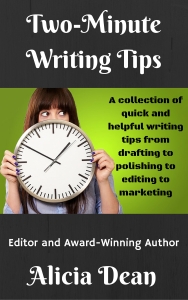Got two minutes? Then check out this week’s quick tip ~ Lee Child’s advice: Tell, don’t Show
Hello and welcome…I am a freelance editor and an editor for The Wild Rose Press, as well as an author. I often struggle with my own writing, and I have found that sometimes, a little reminder of ways to improve the process can be helpful, so, I like to share these moments of brilliance with others :). But, in this busy world of ours, who has time for pages and pages of writing tips? That’s why I’ve condensed mine down to quick flashes you can read in (approximately) two minutes. Enjoy…
Disclaimer: All of my tips are suggestions, and are only my opinion. And, for the most part, there are exceptions when going against my advice will make your story read better. Take what works, leave the rest.
Lee Child is one of my favorite authors. I LOVE the Jack Reacher books. He, like a lot of my favorite suspense/thriller authors, does not write with a lot of emotion. It’s a style that is part of that genre, and it works well for me. I don’t need a ton of emotion, especially when I’m engrossed in an intense thriller. I hadn’t really thought about his voice/style, but after reading his advice on ‘showing,’ I wondered if he did a lot of telling, which is supposedly a no-no, and I just hadn’t noticed. Here is what he had to say about it:
Picture this: In a novel, a character wakes up and looks at himself in the mirror, noting his scars and other physical traits for the reader.
“It is completely and utterly divorced from real life,” Child said.
So why do writers do this? Child said it’s because they’ve been beaten down by the rule of Show, Don’t Tell. “They manufacture this entirely artificial thing.”
“We’re not story showers,” Child said. “We’re story tellers.”
Child said there’s nothing wrong with simply saying the character was 6 feet tall, with scars.
After all, he added—do your kids ever ask you to show them a story? They ask you to tell them a story. Do you show a joke? No, you tell it.
“There is nothing wrong with just telling the story,” Child said. “So liberate yourself from that rule.”
Child believes the average reader doesn’t care at all about telling, showing, etc. He or she just wants something to latch onto, something to carry them through the book. By following too many “rules,” you can lose your readers.
I think he has some good points. We don’t want to get so bogged down in rules that we lose our story. Also, you can overdo it with the showing. However, I think Mr. Child does more ‘showing’ than he would lead us to believe.
Excerpt from “Worth Dying For” by Lee Child:
Reacher checked the window. There were four tires in total, big knobbly off-road things, all of them on a Ford pick-up truck. The truck had a jacked suspension and lights on a roof bar and a snorkel air intake and a winch on the front. There were two large shapes in the gloom inside. The shapes had thick necks and huge shoulders. The truck nosed slowly down the row of cabins and stopped twenty feet behind the parked Subaru. The headlights stayed on. The engine idled. The doors opened. Two guys climbed out.
They both looked like Brett, only bigger. Late twenties, easily six-six or six-seven, probably close to three hundred pounds each, big waists made tiny by huge chests and arms and shoulders. They had cropped hair and small eyes and fleshy faces. They were the kind of guys who ate two dinners and were still hungry afterward. They were wearing red Cornhuskers football jackets made gray by the blue light from the cabin’s eaves.
The doctor’s wife joined Reacher at the window.
“Sweet Jesus,” she said.
Reacher said nothing.
The two guys closed the truck’s doors and stepped back in unison to the load bed and unlatched a tool locker bolted across its width behind the cab. They lifted the lid and one took out an engineer’s ball-peen hammer and the other took out a two-headed wrench at least a foot and a half long. They left the lid open and walked forward into the truck’s headlight wash and their shadows jumped ahead of them. They were light on their feet and nimble for their size, like football players usually were. They paused for a moment and looked at the cabin’s door, and then they turned away.
Toward the Subaru.
They attacked it in a violent frenzy, an absolute blitzkrieg, two or three minutes of uncontrolled smashing and pounding. The noise was deafening. They smashed every shard of glass out of the windshield, they smashed the side windows, the back window, the headlights, the tail lights. They hammered jagged dents into the hood, into the doors, into the roof, into the fenders, into the tailgate. They put their arms through the absent glass and smashed up the dials and the switches and the radio.
Shit, Reacher thought. There goes my ride.
“My husband’s punishment,” the doctor’s wife whispered. “Worse this time.”
The two guys stopped as suddenly as they had started. They stood there, one each side of the wrecked wagon, and they breathed hard and rolled their shoulders and let their weapons hang down by their sides. Pebbles of broken automotive glass glittered in the neon and the boom and clang of battered sheet metal echoed away to absolute silence.
Reacher took off his coat and dumped it on the bed.
The two guys formed up shoulder to shoulder and headed for the cabin’s door. Reacher opened it up and stepped out to meet them head on. Win or lose, fighting inside would bust up the room, and Vincent the motel owner had enough problems already.
The two guys stopped ten feet away and stood there, side by side, symmetrical, their weapons in their outside hands, four cubic yards of bone and muscle, six hundred pounds of beef, all flushed and sweating in the chill.
Reacher said, “Pop quiz, guys. You spent four years in college learning how to play a game. I spent thirteen years in the army learning how to kill people. So how scared am I?”
Sigh….when you’re Lee Child, and your character is Jack Reacher, who needs showing? However, lines like this: ‘Pebbles of broken automotive glass glittered in the neon and the boom and clang of battered sheet metal echoed away to absolute silence.’ In my opinion, are showing. As far as emotion, you don’t need melodrama. I felt the emotion in that scene, easily. Even though Reacher is not given to hysterics, and even though it was brief, the doctor’s wife’s emotions were clear. And, Reacher’s intent to do bodily harm was clear. I was completely in the scene. I could see it, feel it, hear it. I will say that, writing in first person helps. You naturally ‘show’ more when in first person.
Bottom line, I think it’s about a few things…
- Don’t worry about showing in the first draft. Write it as quickly as you can, just get the story out. Perhaps even write in first person (you can switch to third in the second round) so you’ll be inclined to ‘show.’
- When you are revising, look for places where you can make the scene a little more vivid by using senses and unique descriptions and avoiding ‘filter’ words such as ‘saw’ ‘heard’ ‘realized’ ‘noticed’ ‘felt’ etc.
- Find a balance between showing and telling. Like in the excerpt above, a few well-chosen words can put us immediately in the scene, right with the action.
Until next time…Happy Writing!
~*~*~*~*~*~*~*~*~*~*~*~*~*~*~*~*~*~*~*~*
ONLY 99 cents!!
(Click on the cover to be taken to the Amazon Buy Page)
~*~*~*~*~*~*~*~*~*~*~*~*~*~*~*~*~*~*~*~*
*** If you would like to send me a few sample pages (around 7500 words or so, even though I will not edit that many on the blog. It just gives me more to choose from) for me to edit and share on an upcoming blog post, please do so in the body of an email to AliciaMDean@aol.com. Please use the subject line: “Blog Submission” This is for published or unpublished authors. In the email, please include whether you would like me to use your name or keep it anonymous, and whether or not you would like me to include any contact info or buy info for your books. Also, you can let me know if you would like for me to run my edits by you before posting on the blog. Please keep in mind, this is for samples to use for blog posts. I will not edit or use samples from all the submissions I receive, but I will use as many as possible.
~*~*~*~*~*~*~*~*~*~*~*~*~*~*~*~*~*~*~*~*
How to write a novel? That is the question. There are probably as many answers to that question as there are people who ask it.
Wanting to write and actually doing it are two very different things. I am well acquainted with the sometimes grueling process of churning out a story. Over the years, I have tried many methods for creating and completing manuscripts, and have tweaked and honed it down to a workable (for me) process.
Using specific examples from one of my own novels, Without Mercy, I share my method in this mini how to book. The first eight steps actually deal with plotting while the last two are designed to help expand your outline into a well-developed draft. There is no one, perfect way to create a story, but there will be a method, or methods that work for you. I’m not sure if this is the one, but it works for me. Only you can decide if it also works for you. Fingers crossed that it does!
*** Warning – Please do not purchase without reading a sample. (This is solid advice for any book, fiction or non. If you are not intrigued in the sample, you will likely not enjoy the book)
Amazon: Click Here





I do like a mix of “show” and “tell,” with emphasis on show. Works best for me. Helpful post. Thanks!
LikeLike
Understanding exactly what is meant by “telling” is a big deal for new writers to learn. It took me a long time to grasp the concept. I agree, the sample you posted is full of “showing.” His “‘Shit,’ Reacher thought, ‘There goes my ride,'” is a perfect example. I don’t read the books, but I learned something about Reacher just from that one line (at least I think I did!). Childs is probably so good at it, he doesn’t even know he’s doing it!
LikeLike
Exactly! He’s definitely excellent at ‘showing’ character. Thanks for stopping by!
LikeLike
Great post! I think Lee Child writes a lot more “showing” than he admits to. I could envision the whole scene because of his excellent showing.
LikeLike
Thanks, Ellen. Yes, I agree. I was right there in the scene just with that brief snippet.
LikeLike
Maybe all those critiques (and contest comments) have overdone the whole show/tell thing. Too many rules taken to extremes. I do think he could have tightened up some of his sentences, though. But who am I to judge? 🙂 He’s the one making the big bucks.
LikeLike
I agree, Diane. Readers really don’t pay much attention to that. Yes, I’m sure we could probably edit any book out there, but we can’t argue with success. 🙂
LikeLike
Hi Alicia,
I’d say that excerpt is about ALL show. I kind of have to roll my eyes at his suggestion that telling the story is fine since he shows all the action!! 🙂
Thanks for another thought provoking post!
Kimberly Keyes
LikeLike
Yes, I am a day behind, but I’m glad you’re not. Great tips, as ever, Alicia. Thanks so much for posting these.
LikeLike